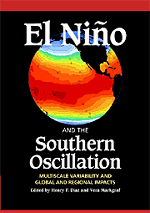Book contents
- Frontmatter
- Contents
- Contributors
- Acknowledgments
- Preface
- SECTION A Global and Regional Characteristics and Impacts of ENSO Variability
- 1 ENSO and Climatic Variability in the Past 150 Years
- 2 Understanding and Predicting Extratropical Teleconnections Related to ENSO
- 3 Global Modes of ENSO and Non-ENSO Sea Surface Temperature Variability and Their Associations with Climate
- 4 Multiscale Streamflow Variability Associated with El Niño/Southern Oscillation
- 5 El Niño/Southern Oscillation and the Seasonal Predictability of Tropical Cyclones
- 6 Climate and ENSO Variability Associated with Vector-Borne Diseases in Colombia
- SECTION B Long-Term Changes in ENSO: Historical, Paleoclimatic, and Theoretical Aspects
- Index
1 - ENSO and Climatic Variability in the Past 150 Years
from SECTION A - Global and Regional Characteristics and Impacts of ENSO Variability
Published online by Cambridge University Press: 04 August 2010
- Frontmatter
- Contents
- Contributors
- Acknowledgments
- Preface
- SECTION A Global and Regional Characteristics and Impacts of ENSO Variability
- 1 ENSO and Climatic Variability in the Past 150 Years
- 2 Understanding and Predicting Extratropical Teleconnections Related to ENSO
- 3 Global Modes of ENSO and Non-ENSO Sea Surface Temperature Variability and Their Associations with Climate
- 4 Multiscale Streamflow Variability Associated with El Niño/Southern Oscillation
- 5 El Niño/Southern Oscillation and the Seasonal Predictability of Tropical Cyclones
- 6 Climate and ENSO Variability Associated with Vector-Borne Diseases in Colombia
- SECTION B Long-Term Changes in ENSO: Historical, Paleoclimatic, and Theoretical Aspects
- Index
Summary
Abstract
Efforts to improve our understanding of the various types of natural variability inherent in the global climate system have included a growing focus on interactions between the El Niño/Southern Oscillation (ENSO) phenomenon and lower frequency decadal- to secular-scale fluctuations in climate. New global historical instrumental data compilations are being analyzed by increasingly more sophisticated objective analysis techniques that are beginning to resolve important physical links and modulations involving dominant climatic signals. This chapter details the current historical observational evidence for interactions between ENSO and decadal- to secular-scale fluctuations in the climate system.
Spectral analyses of global historical sea surface temperature (SST) and mean sea level pressure (MSLP) anomalies reveal significant climatic signals at about 2–2.5,2.5–7, 11–13, 15–20, 20–30, and 60–80 years and a long-term secular trend. The spatial and temporal characteristics of the SST and MSLP signals in these bands are resolved and examined by using joint empirical orthogonal function (EOF) and singular value decomposition (SVD) analyses. The ENSO signal is seen to consist of quasi-biennial (QB) (2- to 2.5-year) and lower frequency (LF) (2.5- to 7-year) components that interact to produce important modulations of the phenomenon. However, longer duration ENSO characteristics and climatic fluctuations are the result of decadal- to secular-scale influences. Protracted El Niño and La Nina phases are found to be a consequence of the “phasing” of quasi-decadal (11- to 13-year) and interdecadal (15- to 20-year) ENSOlike signals with higher frequency QB and LF ENSO components.
- Type
- Chapter
- Information
- El Niño and the Southern OscillationMultiscale Variability and Global and Regional Impacts, pp. 3 - 56Publisher: Cambridge University PressPrint publication year: 2000
- 29
- Cited by



